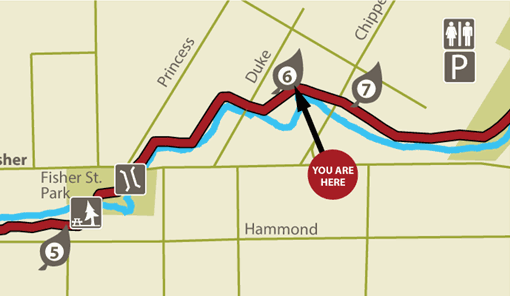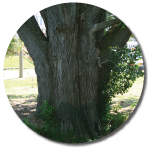"Oh Boy! Nothing like cooling off in the shade under a big tree. It's cooler in the Creek too, just what fish like! Thanks to all you kids who help plant trees along the Creek!"


Unique Trees
From this vantage point you can see two very unique trees. Looking to your left, there is a tall tree overhanging the trail. This is a black walnut (Juglans nigra), which is near its limit for cold hardiness here in North Bay. Black walnut grows mostly in riparian zones (beside water), gets as high as 30 to 40 metres (98-130 ft) and bears nuts in September-October, usually more abundantly every other year. The shells are very hard to remove and will stain your hands dark brown. The nuts are used in cooking and the shells used in abrasive cleaning products, cosmetics, oil well drilling and water filtration. The leaves are 30-60 cm long with 15-23 leaflets that are 7 to 10 cm long and 2-3 cm wide, one of the best ways to identify a black walnut.
Look to your right, across Duke St. just around the bend and you’ll see a very tall, large poplar tree towering above the other trees next to the Creek, around the bend. It has many, many trunks and is arguably the largest tree in our area! It’s well known by many local children who climbed it sometime in the many decades it’s been growing. People often develop a fondness for large, long-standing trees and, like this one, see it as an important part of the community.
Trees alter the environment by moderating climate, improving air quality, conserving water and providing a home for birds and wildlife. When they grow near creeks and waterways like Chippewa Creek they have many physical and biological benefits.

Trees & Creeks
Why are trees so important?
Trees, shrubs and smaller plants help protect against erosion from fast-moving water, especially during flooding. Riparian (shoreline) vegetation slows the stream’s current and traps the silt or sand carried in floodwaters. They help stabilize the shoreline.
Most nutrients, like nitrogen or phosphorus used in cleaning products, are considered pollutants when they enter the Creek. Plants act like filters: they take up these nutrients for growth. They also take up toxins such as salt and heavy metals. By filtering pollutants, plants reduce the amount of nutrients and toxins reaching the water during spring snowmelt and in heavy rain.
Trees moderate the impacts of the sun, wind and rain. Alongside the Creek they help shade and cool the temperature of the water. Radiant energy from the sun, pavement and buildings is absorbed or deflected by leaves. Tree roots intercept water, store some of it, and reduce the speed of moving stormwater runoff, helping reduce the risk of flooding.
Tree stumps, root wads and brush can provide important habitat for fish. Whether naturally occurring or anchored in the shallow waters of the Creek, they provide protection, spawning and food production areas for the fish. Trees and shrubs also provide habitat for insects that feed the fish.

Trees & People
What about the air we breathe? Leaves filter the air by removing dust and other air pollutants such as ozone, carbon monoxide and sulfur dioxide. Trees also help us adapt to climate change impacts by taking in carbon dioxide and releasing oxygen, helping to reduce greenhouse gas emissions.
Trees provide a windbreak to protect people, pets and buildings; the more compact the leaves or group of trees, the greater the benefits of the windbreak.
Economically, trees play an important role in energy cost savings and increasing property value. Summer air conditioning and winter heating costs are lower in a tree-shaded home. When these individual savings are added up for a community, they reduce the community’s need for expensive non-renewable forms of energy, like oil and gas. Trees increase in value from the time they are planted until they mature and add to the value of a home much like having an updated kitchen or bath.
Research shows that trees play a role in health and wellness. In a series of studies, scientists found that when people spend time in more natural surroundings — forests, parks and other places with plenty of trees — their immune system is boosted. Scientists chalk it up to phytoncides, airborne chemicals that plants emit to protect them from rotting and insects and which also seem to benefit human health.



